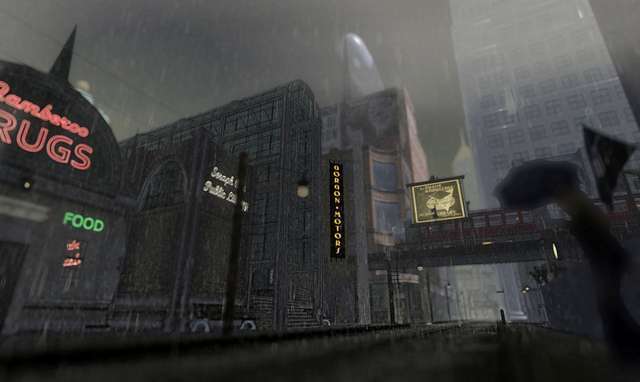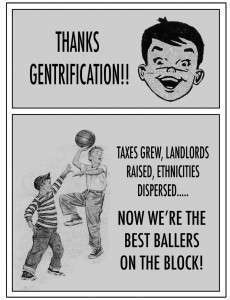“It is a bad place,” the native says in a hushed whisper. “Don’t go in there!” You can easily see the area that he’s pointing at near the edge of the village. It’s a fenced off grove of densely-packed trees. The lighting is a little different there, and some of the trees even have strange writings carved into them. “If you go in there, bad things will happen to you,” he continues with fear in his eyes. As a Christian missionary standing next to this native, you’re not scared. You know better than to believe the simple superstitions and pure coincidences that undoubtedly led to this native’s fear. The God you know is stronger than any real or imagined evil spirit. You feel bad for this native because you know–there’s no such thing as a “bad” place.
Now, change the “bad” place in a third world country to a “bad” neighborhood in our own backyard. Suddenly, our fears are legitimate. “It’s a bad neighborhood,” we say to each other. “Don’t go in there.” It’s easy to recognize that part of town, that part of the city, that side of the tracks. The lighting is a little different, the sidewalks are cracked, and sometimes the strange writing of graffiti decorates the walls. The plots on old Law and Order episodes have warned us, “If you go in there, bad things will happen to you.”
 America is afraid of “bad” neighborhoods. No one wants to live in a neighborhood with a reputation for poverty and crime. If you happen to live in a neighborhood like this, you have two options: Buy into the American Dream and tie your self-worth to your ability to get out of your “bad” neighborhood. The other option is to resign yourself to living in this neighborhood and blame your problems on the place where you live. If you’re fortunate enough to live in a nicer neighborhood, you comfort yourself with the status symbol of your lovely home. Your house is always more expensive than the clothes you wear or the car you drive. Its “location, location, location” let’s people know how well you’re doing.
America is afraid of “bad” neighborhoods. No one wants to live in a neighborhood with a reputation for poverty and crime. If you happen to live in a neighborhood like this, you have two options: Buy into the American Dream and tie your self-worth to your ability to get out of your “bad” neighborhood. The other option is to resign yourself to living in this neighborhood and blame your problems on the place where you live. If you’re fortunate enough to live in a nicer neighborhood, you comfort yourself with the status symbol of your lovely home. Your house is always more expensive than the clothes you wear or the car you drive. Its “location, location, location” let’s people know how well you’re doing.
In my experience, Christians aren’t much different. Growing up, one of our church leaders who had lived in the city his whole life, always talked about how much he hated the city and wanted to move out. My church is in a “bad” neighborhood. Through the years, most people stop coming, not because they’ve found a different church, but because they’ve found a better neighborhood. We’ve had visitors on the way to our church that turned around as soon as they saw the area it was in. A few years back, I met a couple at a conference outside the city who had grown up in my neighborhood, but now lived in the suburbs. They said that whenever their kids are misbehaving, they punish them by driving them through their old neighborhood. Apparently my neighborhood is pretty terrifying stuff.
Here’s the crazy thing about “bad” neighborhoods–they don’t exist. Let me show you what I mean:
1. Because God is omnipresent, God is in every neighborhood.
If you grew up in Sunday School, you can probably remember learning the word “omnipresent.” It made you feel smart that you knew such a big word, a word that means God is every where. Grudem says “omnipresence” means that, “God does not have size or spatial dimensions and is present at every point of space with his whole being…” (Systematic Theology, p. 173) There is no place without God. In Psalm 139 David glories that there is no place without God’s presence: heaven or hell, light or darkness, sea or land. “Even there shall your hand lead me and your right hand shall hold me” (v.10). Believers know that they can’t get away from the incredibly-comforting, slightly-terrifying presence of God.
We often forget that God is near, but there’s something about certain neighborhoods that makes us forget God’s presence entirely. We see a few broken windows, a little graffiti, and an abandoned house, and suddenly we believe that God is no where to be found. We see one indication of poverty, and we assume the absence of God. We are culturally conditioned to allow a sense of dread and fear to come over us when we encounter a “bad” neighborhood.
 Christians ought to be different. We shouldn’t let our feelings or surroundings determine the presence of God. He is everywhere. A.W. Tozer says we experience the presence of God by “recogniz[ing] the real presence of the One whom all sound theology declares to be already there, an objective entity, existing apart from any apprehension of Him on the part of His Creatures.” (Knowledge of the Holy, p. 53) It doesn’t matter what we feel, God is just as present in a “bad” neighborhood as He is in a “good” neighborhood.
Christians ought to be different. We shouldn’t let our feelings or surroundings determine the presence of God. He is everywhere. A.W. Tozer says we experience the presence of God by “recogniz[ing] the real presence of the One whom all sound theology declares to be already there, an objective entity, existing apart from any apprehension of Him on the part of His Creatures.” (Knowledge of the Holy, p. 53) It doesn’t matter what we feel, God is just as present in a “bad” neighborhood as He is in a “good” neighborhood.
Neighborhoods aren’t God forsaken, but they are forsaken by (some of) the gods of our culture. Our society worships at the feet of the gods of safety, materialism, and achievement; “bad” neighborhoods are places where these gods have no power. Their absence proves that worldly things are not real gods because they are not omnipresent. Of course, it’s uncomfortable for people who worship these gods to go to places where their gods don’t exist. Christians are different, though. Our God isn’t made with human hands, and He can’t be confined to any one place. Our God is omnipresent. Wherever He is, we can go.
“Bad” neighborhoods turn good Christians into fearful atheists. Good, basic theology will rescue us. It gives us an Almighty God who is in every place.
Click here for Part 2: Because God is Creator, every neighborhood has His image bearers.
Shortlink for Sharing This Article: http://wp.me/p45Knq-2d


